#Scottish Kirkyards
Text

At the last resting place of Edinburgh poet Robert Ferguson, who sadly passed away at the young age of 24, Robbie Burns was a fan and paid for the gravestone you see after discovering his grave was unmarked.
Here are a few lines from his poem The Daft Days , where he talks about Aqua Vitae, thats whisky tae you and aye. His warning is that when fou (full) we are sometimes capernoity (Crabbit) and have to be wary of Edinburgh's City Guard, the original Polis of Auld Reekie.
"And thou, great god of Aqua Vitæ!
Wha sways the empire of this city,
When fou we're sometimes capernoity,
Be thou prepar'd
To hedge us frae that black banditti,
The City-Guard."
33 notes
·
View notes
Text
Look I love a Spooky Edinburgh Moodboard as much as the next person but I do wonder whether the people who tag pictures of St Giles and the General Assembly Hall as "witchy” or dark academia aesthetic have any idea what they’re looking at
#Edinburgh#Look nothing says witchy like Presbyterianism you heard it here first folks#Keep doing it actually maybe we could power Scotland by hooking up a generator to the graves of hardline seventeenth century ministers#as they proceed to spin in their graves faster than the Mallard's wheels#This would be delightful#Interesting how history plays out for all their attempts to make Scotland a covenanted nation we're probably the most secular bit of the UK#And a lot of the tourists who come to Edinburgh don't even seem to know what denomination the Church of Scotland is#Now I'm mildly inclined towards the church myself but thank god it's modernised considerably even in the last 50 year#Though it is difficult to try to explain to people what an important force Presbyterianism was in Scottish history when it's barely visible#Auld Reekie#Athens of the North#To be fair though the whole Presbyterian Schtick probably DID influence a lot of Scotland's 'witchy' aesthetic#Beyond the whole horrendous persecution of the early modern period#Certainly if St Giles had remained a Catholic church I think it would have had a distinctly different vibe#Though it's not exactly the best example of a Presbyterian church given its Victorian refurbishment#Little bare parish churches with dark pews and scratched flagstone floors and whitewashed walls and a kirkyard full of odd symbols#Lovely places#Terrible places#The power of the Kirk was immense and it's so strange that we've almost entirely shrugged it off#Maybe Chris Guthrie was right
14 notes
·
View notes
Text
In honour of Burns night (January 25th), please accept this Scots-ish (NOT Scottish) poem about bonnie Mr. McFell from his wee demon.
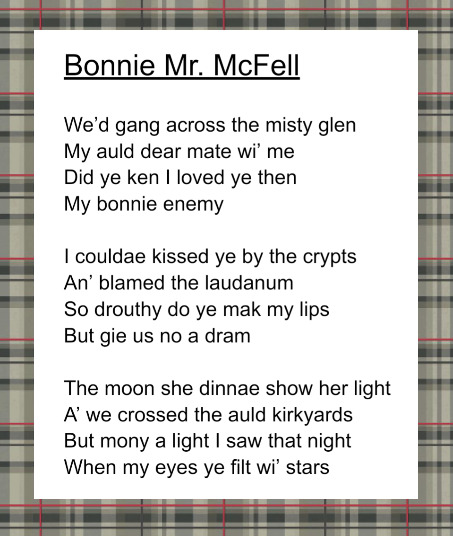
We’d gang across the misty glen
My auld dear mate wi’ me
Did ye ken I loved ye then
My bonnie enemy
I couldae kissed ye by the crypts
An’ blamed the laudanum
So drouthy do ye mak my lips
But gie us no a dram
The moon she dinnae show her light
A’ we crossed the auld kirkyards
But mony a light I saw that night
When my eyes ye filt wi’ stars
Read more of my work here.
This poem is also available on AO3.
#good omens#aziraphale#crowley#ineffable husbands#i spent a normal amount of time on this#that 1827 date in Edinburgh#heavens dress tartan#burns night#poem#poetry#i know where I'm going#Burns-ish Scots-ish poem#Scots-ish not Scottish
68 notes
·
View notes
Text

Haunted Tomb of a Torturer
One of the most haunted properties in Scotland, Greyfriars’ Kirkyard, sits behind the base of Edinburgh Castle near an area called Grassmarket in Edinburgh.
In the 1600s, thousands of Scottish Presbyterian Covenanter were imprisoned in Greyfriars’ Kirkyard for not converting to the Church of England. George Mackenzie was the Lord Advocate to the King in Edinburgh. It was his responsibility to punish the men, women, and children prisoners as he saw fit. It is said he personally enjoyed his work. The prisoners were tortured, left out in the elements during the winter, starved, and beheaded. During his time as Lord Advocate, he killed over 18,000 fellow Scots. His reign was known as The Killing Time. The ground was often red and coppery smelling from the blood, gore, and bodies. Even today it is said that the soil is 10% human DNA.
The dead prisoners were buried in mass, unmarked graves in the back of the lot near where they spent their last days suffering but dying for what they believed.
Upon his death, George MacKenzie was buried just feet away from the site of his horrific war crimes. The grave also borders the mass graves of prisoners and plague victims.
One night a vagrant vandalized the tomb of George and his family. The coffins were opened and remains defiled. During the assault, the floor of the tomb collapsed and the man fell into a pit of buried plague victims. The man was killed by the fall or perhaps the sheer horror of falling into a pit of human remains.
The next morning a young woman found the vandalized tomb and the dead man in the pit. As she rushed to find authorities, she began to feel as if something was choking her and she passed out. When she was found, there were finger marks on her neck.
Since then many visitors have reported scratches, burns, and bruises. It is said that the spirit of George MacKenzie was awakened and vengeful, blaming the common folk for disrupting his peace. He has since become known as one of the most active poltergeists in the world. Thousands of visitors have documented scratches and marks while visiting Greyfriars.
There is no doubt, due to the horrific history drenched with tortured souls on blood soiled grounds, the testimonies of poltergeist activity and the abundant evidence that has been collected through the years, this is one of the most haunted cemeteries in the world.

#Haunted Tomb of a Torturer#George MacKenzie#Greyfriars#haunted salem#myhauntedsalem#ghost and hauntings#paranormal#ghost and spirits#haunted locations#paranormal phenomena#supernatural#haunted#hauntings#spirits#ghosts
6 notes
·
View notes
Text


someone's work from the blue themed exhibition I'm part of
explicitly local work is always good
delicacy
oldschool Scottish slang creates an interesting sound- simulatebously rough (whit, kirkyard) and soft (Doon, aw, fleein, roon) - kind of like jazz
sentimentality!!!!!! work should always always have it
you can always tell if the artist is being genuine or not and here you can tell they are
detail- DREAMS banner- beautiful
achieved something I'm trying to do- balance of rustiness and delicate beauty
0 notes
Text
Graveyards by the sea

Abandoned churches dotted along the Aberdeenshire coast give it a pleasingly godforsaken feel.
The regional council has put out a guide to 12 of the best such ruins. Here is my short list, from south to north (map at the end of this post.)
The remains of St Mary's Church, in Cowie - pictured above and below - sit oddly between a golf course and cliffs overlooking Stonehaven Bay.

The 13th-century chapel was dedicated to "St Mary of the Storms" but fell into disuse in the 1560s. Perhaps the newly Protestant kirk objected to involving the Holy Virgin in maritime meteorology. A panel at the site only says that the church "was unroofed by the ecclesiastical authority on account of certain scandals".
Locals recycled the crumbling walls as building material, despite a rumour that the stones would "rain blood upon any house built with them".
There was an attempt to rebuild the chapel in the 19th century. The churchyard includes a memorial to a Stonehaven lifeboat crew who perished in a failed rescue in 1874. Far from bringing succour to seamen, it seems, the site was jinxed. Parishioners deserted it.
The adjacent golf clubhouse, on the other hand, is doing brisk business.
Twenty kilometres to the north is another former church in an incongruous setting. The ruins of St Fittick's Church stand next to the south shore of Aberdeen harbour.

The 12th-century chapel was named after an Irish monk who set out to evangelise the Picts in the 600s. According to legend, Fittick's boat was caught in a storm. He told the sailors that salvation lay in Christ. They threw him overboard to placate Manannán mac Lir, the god of the sea.
But the holy man had the last laugh. He managed to swim to the shore. When the villagers asked him how he had survived the wrath of Manannán mac Lir, Fittick said: "Salvation lies in belief in Christ."
The church testifies to the complex relationship between Scots and their fellow Celts across the Irish Sea.

The kirkyard features the gravestone of one William Milne, a victim of Britain's civil wars of the 17th century (my post about the Scottish part of that conflict is here).
Milne, a farmer, joined a Protestant "Covenanter" militia during a royalist offensive backed by Irish Catholics. The Latin epitaph says that he fell in 1645"for the cause of Christ... by the sword of a savage Irishman".
Fifty kilometres up the coast is Longside Old Parish Church, built in 1619-20.
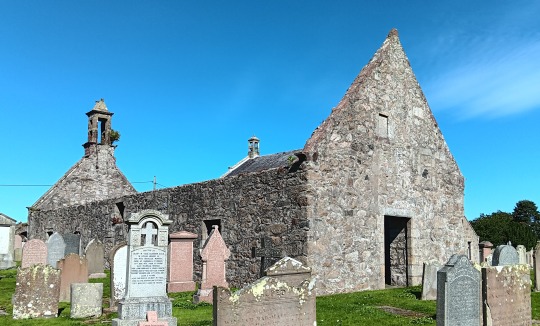
The churchyard features many memento mori symbols: skulls and bones, hourglasses and the like.
My favourite gravestone is that of William Reid, who "depairted this life" in 1702 and "rests in hops of blesed resurection". I quote this not to mock the spelling, but my own obsession with spelling.
Soon I will be gone, as will the linguistic proprieties I held so dear. For a pedant, this stone is the most poignant memento mori of all.

St Mary Chapel, Rattray, is another monument to transience.
Rising from flatlands that seem to merge into the sea, it is all that remains of the "royal burgh" of Rattray.
That status was granted by Mary Queen of Scots to encourage local clans to engage in commerce rather than feuds. Thus Rattray gained the right to hold markets and trade far and wide.
The sea had other ideas. Winds and currents filled the harbour with sand over the years. By the 1800s the village had vanished, as if engulfed by the soggy ground.

But the shell of the 13th-century chapel still stands, at the end of a single lane that seems to lead nowhere.
A few kilometres inland, on the outskirts of Fraserburgh, is St Ethernan's, Rathen.
A front gable and a side wall are all that's left of this 17th-century parish church.

The stars of the kirkyard are John Greig and Anne Milne, a couple of tenant farmers who happened to be the great-great-grandparents of Norwegian composer Edvard Greig.
One of their sons emigrated and became a successful merchant in Bergen.
Three generations later, little Edvard learned how to play the piano and the rest is musical history.

The inscription on the gravestone is quite worn but someone deciphered it: "Here lyes the remains of JOHN GRIEG, late tenant in Mostoun of Cairnbulg d 6 Jan 1774 in his 71st year. Here also was laid the body of ANN MILNE, spouse of above named John Greig d 17 Nov 1784 in 81st year. This stone is erected to his memory by his surviving children."
The survivors refrained from mentioning the couple's connection to an illustrious descendant. Another lesson in humility!
Fraserburgh is home to an informative Museum of Scottish Lighthouses. Those uninterested in nautical beacons can happily skip that town and follow the coastline to the west.

The highlights of the northern Aberdeenshire seaboard are fishing villages that are little more than strip of cottages between water and cliff.
They look cute now but were born of desperation. Farm labourers settled these unpromising shores in the 18th century, after being evicted in the Highland Clearances.
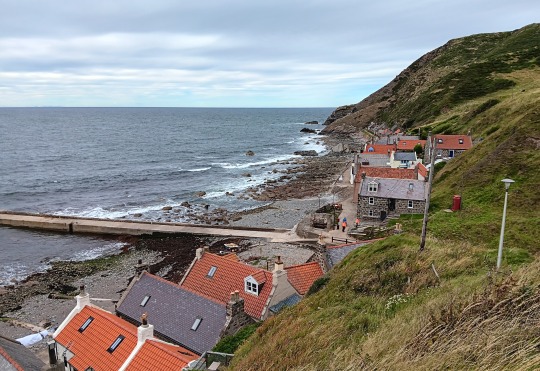
One of the most picturesque of those villages is Crovie (above). There is not even room for a road either in front or behind the cottages.
The most famous is Pennan, which was put on the map by Bill Forsyth's film Local Hero.

Its phone box plays a big part in the movie - made in the dark, pre-mobile ages.
Forty years on, the red kiosk is still there.
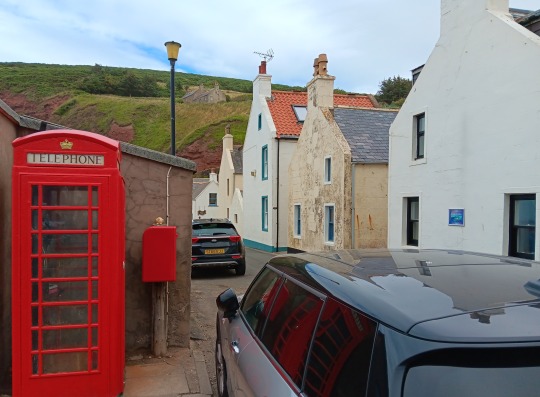
The Aberdeenshire council has apparently kept it in service as a tourist attraction.
Talking about maps, here's the one I promised (forgive its crudeness: the only cartographical tool my incompetence can handle is Google My Map.)
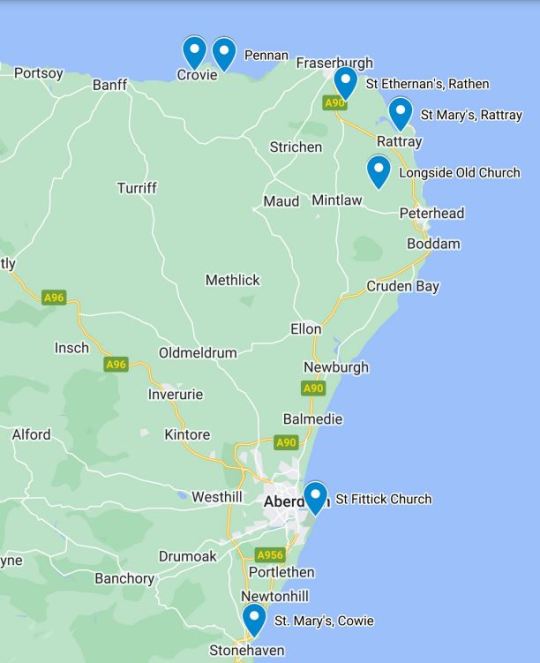
1 note
·
View note
Photo

ℹ️ This tree was the only one of its kind in the cemetery beside The Parish Church of St. Cuthbert. It has a stiff texture and is spikey throughout, even the trunk. 📍Parish Church of St. Cuthbert, Scotland 📅 September 2022 🔖@edinburghuniversity @edinburgh.photos @street.classics @streets_storytelling @scotland.explores #️⃣ #scotland #scottish #scot #truescotsman #scotlandtravel #edinburgh #edinburgh #edinburghcity #city #aesthetic #aesthetics #cityscapes #cityaesthetics #britishisles #uk #scotch #cityphotography #photography📷 #photography #travel #travelling #travelphotography #monuments #statue #gothic #death #cemetery #kirkyard #tree #nature (at Edinburgh) https://www.instagram.com/p/Cn6o-wKuyAT/?igshid=NGJjMDIxMWI=
#scotland#scottish#scot#truescotsman#scotlandtravel#edinburgh#edinburghcity#city#aesthetic#aesthetics#cityscapes#cityaesthetics#britishisles#uk#scotch#cityphotography#photography📷#photography#travel#travelling#travelphotography#monuments#statue#gothic#death#cemetery#kirkyard#tree#nature
1 note
·
View note
Photo

Old High Church Kirkyard in Inverness, Scotland
Following the Scottish defeat at Culloden, this graveyard became a “killing field.” Perched on St. Michael’s Mount overlooking the River Ness, the Old High St. Stephen’s Church is the oldest church in Inverness, Scotland. It's been a place of worship since the Irish missionary St. Columba visited the Scottish Highlands in the 6th Century. It is believed to be where he converted the Pictish King Brude to Christianity in 565. Much of the current building was constructed in 1770, but the church tower base dates to at least the 1300s, making it the oldest standing building in Inverness. Although a place of worship and devotion for centuries, the Old High Church’s Kirkyard, the graveyard beside the church, was the site of an atrocity following the Battle of Culloden on April 16, 1746. The battle lasted less than an hour. English forces decisively defeated the Jacobite army of Charles Edward Stuart, a.k.a. Bonnie Prince Charlie, marking the end of the Jacobite Uprising of 1745 and all efforts to restore a Stuart king to the throne of England and Scotland. Following the devastating loss, hundreds of Jacobite prisoners were brought to Inverness, some of whom were then imprisoned in the tower of the Old High Church. Many of the Jacobite prisoners were wounded or ill. The conditions were harsh, and those not already sick soon weakened from cold and starvation. Rather than transport the Scottish prisoners to England, many were hastily tried and sentenced in the Church and then executed among the graves in the Old High Church Kirkyard. A firing squad executed condemned prisoners in front of the stone masonry outside the blue-painted door of the Church tower. Divots from errant musket balls still pockmark the tower's wall. Prisoners unable to walk or stand were taken to the center of the Kirkyard and seated against a gravestone. A direct ten paces from that gravestone was another whose top featured a heart-shaped cleft. A sharpshooter would lay behind the second stone and use its notch to steady their musket before firing at the injured condemned soldier. The Kirkyard’s stone wall stopped any stray bullets. Balnain House, a Georgian townhouse directly across the river from the Old High Church, was used as an English field hospital following the Highland battles. Wounded Hanoverian officers recuperating there watched the Kirkyard executions from their hospital windows. How many prisoners died at the Old High Church and how the English disposed of the bodies is unknown. Some believe that the prisoners executed at the Old High Church were buried in a pit beneath what is now a paved walkway next to the Church.
https://www.atlasobscura.com/places/old-high-church-kirkyard
#warriors#war#war history#prisons#execution#murder#graves#gravestones#graveyards#churches#Atlas Obscura
0 notes
Text
“Reflection paper”
In "Prayers for Bobby," Mary Griffith (Sigourney Weaver) is a devout Christian who raises her children with the conservative teachings of the Presbyterian Church. However, when her son Bobby Ryan confides to his older brother he may be gay, life changes for the entire family after Mary learns about his secret. In this adaptation of a true story, devout Christian Mary Griffith (Sigourney Weaver) fights to "cure" her gay son, Bobby (Ryan Kelley). Although he tries to please his mother, Bobby cannot change his lifestyle, and his depression leads to suicide. Mary questions her faith and searches for comfort, but after the church is unable to help her cope with Bobby's death, she seeks to understand her opinions on homosexuality for herself. Eventually, Mary becomes an advocate for gay rights. Greyfriar's Kirkyard is the graveyard surrounding Greyfriar's Kirk (church), and it was a place close to both of the mentioned coffee houses frequented by J. K. Rowling. It has been said that some of the gravestones here may have given Rowling inspiration for some of her famous Harry Potter characters. Eilean na Moine Island in the loch was used as Dumbledore's grave; it was filmed, then digitally placed in Loch Arkaig. Loch Eilt is a freshwater loch in Lochaber in the West Highlands.
Harry Potter fans now know the exact location of an American Hogwarts, but the real one exists in England. Alnwick Castle stood in for the famed wizarding school in Harry Potter and the Sorcerer's Stone and Harry Potter and the Chamber of Secrets. The monument reads, "Greyfriars Bobby – Died 14 January 1872 – Aged 16 years – Let his loyalty and devotion be a lesson to us all". In 2021 a new monument to mark the 150th anniversary of the dog's death was placed close to the east wall of Greyfriars Kirk. However, according to experts in the breed, Greyfriars Bobby is more likely to have been a dandie dinmont terrier which originated in the Scottish borders in the 17th century. Over the years, Greyfriars Bobby's black nose has started to become shiny from all the tourists rubbing the nose of the legendary statue. Many believe that it will bring them good luck in the future. Greyfriars Bobby was a Skye Terrier who became known in 19th-century Edinburgh for supposedly spending 14 years guarding the grave of his owner until he died himself on 14 January 1872. Sweet Tooth showrunner Jim Mickle took to Twitter to post a behind-the-scenes video of everyone's favorite human-groundhog hybrid, Bobby. Is "Dog" Based on a True Story? While it's not entirely based on a true story, elements of "Dog" are inspired by Tatum's life. Lulu, the Belgian malinois in the film, is named after Tatum's beloved late dog. Bobby passed away in January 1872, aged 16 years old, and as a final token to his loyalty, was buried close to his master in the kirkyard. A granite fountain with a statue of Bobby can be found opposite Greyfriars Kirkyard – a permanent memorial to this faithful pup.
0 notes
Photo

Canongate Kirkyard
#My own photography#Canongate Kirkyard#Princes Street#Edinburgh#historic Scotland#Scotland#UK#Stonework#Scottish Kirkyards#old gravestones#cemetery photography#beautiful graves#inscriptions#hourglass detail#skull detail#angel detail#Danny Darke
131 notes
·
View notes
Text

#It's a joke#Bobby is a very nice dog#And we all love him very much#Scottish twitter#toppling statues#statue#greyfriarsbobby#greyfriars kirkyard#Dogs#Edinburgh#Scotland#i wanna boop his nose
56 notes
·
View notes
Text



This sculpture in Canongate Kirkyard is of a Lion-Goat-Serpent mythical creature being wrestled by a naked boy, sited close to Canongate Mercat Cross. Someone has added a daisy chain on its head.
'The last Chimera'
The sculptress is Anglo-Brazilian artist Josephine de Vasconcellos,

16 notes
·
View notes
Text










8/11/19
📍Greyfriars Kirkyard, Edinburgh
#greyfriars kirkyard#greyfriarsbobby#scotland#autumntime#photoblog#photography#vscocommunity#vscocam#vscophoto#scottish#edinburgh#travel#cemetery#outlander#Spotify
9 notes
·
View notes
Text










Check out some of our honeymoon pics.
#london#soho#edinburgh#scotland#greyfriars kirkyard#edinburgh castle#scottish highlands#glencoe#loch ness#honeymoon#the lesbianist honeymoon
19 notes
·
View notes
Photo

Mackenzie Poltergeist in Greyfriars
Greyfriars Kirkyard is the site of one of the most bloody religious persecutions carried out in the 17th century by King appointed Lord Advocate Sir George Mackenzie against the rebel Presbyterian Covenanters for their failure to accept state approved religion and swear loyalty to the King. It is also the location of the most well documented poltergeist activity in the world – the Mackenzie Poltergeist in Greyfriars.
It all began fifty years after the “National Covenant” was signed, pledging to keep Scotland a Presbyterian country, when King Charles II ascended the throne and quickly disavowed the Covenanters right to freely practice their religion and demanded that all accept the new official state religion. On June 22, 1679, the king’s forces swept the last of the Presbyterian Covenanters away in a bloody yet decisive battle known as the Bothwell Brig.
Refusing to swear allegiance to the King, several thousand Presbyterian Covenanter rebels were rounded up and imprisoned in a section of the Greyfriars Kirkyard (the graveyard of the small Greyfriars Kirk parish, owned by The Church of Scotland), known as the Covenanters’ prison.
Over the coming winter months, the Covenanter prisoners of war were branded dissidents and subjected to deportation, inhumane torture, starvation, exposure and beheadings at the hands of Lord Advocate Sir George Mackenzie. Nicknamed “Bluidy MacKenzie”, by his victims, this vile brute was in charge of the Presbyterian Covenanter persecution on behalf of Charles II. And, though his everyday life facade was that of loving husband and father, legal scholar, published author (it’s said he wrote the first Scottish novel) and well read man, the private business of persecution that he conducted on behalf of the king, was so well hidden that even his wife never saw this vicious and sadistic side. The persecution was relentless and in the end, most if not all of the prisoners died and were buried in the Greyfriars Kirkyard cemetery where they had been held captive.
In all, Mackenzie was responsible for the deaths of 18,000 of his countrymen in pursuit of a unified religion, during a period that was labeled, ‘The Killing Time’. His bloody reign of terror came to an end in 1691 when he died and was ironically buried in a casket contained in the Black Mausoleum tomb, a building located on the GreyFriars Kirkyard a short distance from the scene of his gruesome war crimes and where his victims were laid to rest.
For 300 years, both victims and tormentor rested in an uneasy peace, just feet from each other. And, then one dark and stormy night in 1998, a homeless man, possibly wanting shelter from the rain or looking for something valuable to steal, broke into the ‘Black Mausoleum’, a vaulted and well fortified tomb, the final resting place of the infamous ‘Bluidy MacKensie’.
The vagrant ransacked the tomb, smashing caskets on every level until he came to one which held the body of Bluidy MacKensie himself.
While trying to pry open the casket, a large hole opened up in the floor under his feet, dropping the man into a chamber below. The pit was filled with the remains of plague victims, unceremoniously dumped into the hole and covered over during plague days as a quick way to dispose of bodies. Confronted by the putrefied remains and stench of still rotting flesh, the homeless man ran screaming hysterically from the mausoleum into the night, never to be heard from again.
The next day, another passerby looking through the iron gates of MacKenzie’s tomb was (in her own words) “blasted back off it’s steps by a cold force.” Sometime later, another woman was found near the tomb’s entrance lying unconscious and her neck covered with bruises as if someone had tried to choke the life from her.
Had this homeless man awakened an angry spirit, to be let loose on a sleepy and unsuspecting burgh?
Once these stories of the macabre hit the internet, the legend of the Mackenzie Poltergeist in Greyfriars was born and lit up the area like wildfire attracting ghost hunters and macabre seekers from every corner of the earth.
Since 1998, when Mackenzie’s casket was first defiled, over 500 ghostly attacks have been reported by those visiting the tomb, many of these injuries documented with photographs.
So far, documented injuries perpetrated by the MacKenzie ghost include burns, skin gouges (around the neck and abdomen); unexplained bruises; broken fingers; feeling as if one’s hair is being pulled. Some visitors have said they were punched or kicked by an invisible attacker while in the MacKenzie tomb. Others talk of feeling nausea or numbness, strange smells or auditory hallucinations such as wall and floor knocks, all having occurred with multiple witnesses present. Some even claimed the ghost had followed them back home or to a hotel.
In 2000, Colin Grant, an exorcist and minister of a spiritualist church performed an exorcism ceremony on the graveyard. Standing in the cemetery, it’s said he was overcome by the sensation of being surrounded by hundreds of tormented souls and evil spirits trying to break through to the mortal realm. Fearing for his own life, he left quickly, saying the evil was too powerful for him to overcome. A few weeks later, Colin Grant was found dead of a sudden and unexpected heart attack.
Today, many people believe this graveyard is haunted by the Mackenzie Poltergeist, a malevolent spirit who’s hatred lives on from beyond the grave. And, far from a restless or benevolent spirit, he exacts punishment on any who dare disturb his final resting place.
#Mackenzie Poltergeist in Greyfriars#haunted locations#haunted salem#myhauntedsalem#paranormal#paranormal phenomena#ghost and spirits#ghost and hauntings
18 notes
·
View notes
Text
Was in greyfriars kirkyard an found this <3

#<3#scottish#scotland#scottishphotography#photography#plants#plantlife#goth#graveyard#headstones#sad#art#im lonly#lonley#lonly boy#mushroom#lonly girl#greyfriars bobby#greyfriars kirkyard
1 note
·
View note